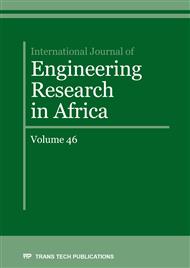[1]
K. Kiasaleh, Receiver Architecture for Channel-Aided, OOK, APD-Based FSO Communications Through Turbulent Atmosphere,, IEEE Trans. Communications, 63(1), pp.186-194, (2015).
DOI: 10.1109/tcomm.2014.2367000
Google Scholar
[2]
L. Yang, X. Song, J. Cheng, and J. F. Holzman, Free-space optical communications over lognormal fading channels using OOK with finite extinction ratios,, IEEE Access, 4, pp.574-584, (2016).
DOI: 10.1109/access.2016.2520936
Google Scholar
[3]
L. Fei and L. Houbing, Optimum detection threshold for free-space optical communication with atmospheric scintillation,, in International Conference on Optoelectronics and Microelectronics (ICOM), (2015), pp.191-196.
DOI: 10.1109/icoom.2015.7398802
Google Scholar
[4]
Z. Ghassemlooy, W. O. Popoola, and S. Rajbhandari, Optical Wireless Communications: System and Channel Modelling with MATLAB, Boca Raton, FL 33487-2742, (2013).
DOI: 10.1201/9781315151724
Google Scholar
[5]
A. O. Aladeloba, A. J. Phillips, and M. S. Woolfson, DPPM FSO communication systems impaired by turbulence, pointing error and ASE noise,, in 14th International Conference on Transparent Optical Networks (ICTON), (2012), pp.1-4.
DOI: 10.1109/icton.2012.6253854
Google Scholar
[6]
Z. Ghassemlooy and W. Popoola, Terrestrial Free-Space Optical Communications, InTech, (2010), pp.355-392.
Google Scholar
[7]
S. Bloom, E. Korevaar, J. Schuster, and H. Willebrand, Understanding the performance of free-space optics, Journal of optical Networking, 2(6), pp.178-200, (2003).
DOI: 10.1364/jon.2.000178
Google Scholar
[8]
J. Park, E. Lee, C. B. Chae, and G. Yoon, Impact of Pointing Errors on the Performance of Coherent Free-Space Optical Systems,, IEEE Photonics Technology Letters, 28(2): pp.181-184, (2016).
DOI: 10.1109/lpt.2015.2489383
Google Scholar
[9]
K. P. Peppas, A. N. Stassinakis, H. E. Nistazakis, and G. S. Tombras, Capacity analysis of dual amplify-and-forward relayed free-space optical communication systems over turbulence channels with pointing errors,, Journal of Optical Communications and Networking, 5(9): pp.1032-1042, (2013).
DOI: 10.1364/jocn.5.001032
Google Scholar
[10]
M. I. Petković and G. T. Đorđević, Effects of pointing errors on average capacity of FSO links over gamma-gamma turbulence channel,, in 11th International Conference on Telecommunication in Modern Satellite, Cable and Broadcasting Services (TELSIKS), (2013), vol. 2, pp.481-484.
DOI: 10.1109/telsks.2013.6704423
Google Scholar
[11]
H. R. Burris Jr, C. I. Moore, L. A. Swingen, L. M. Wasiczko, R. Mahon, M. F. Stell, W. S. Rabinovich, J. L. Murphy, G. C. Gilbreath, and W. J. Scharpf, Laboratory implementation of an adaptive thresholding system for free-space optical communication receivers with signal dependent noise,, in Free-Space Laser Communications, International Society for Optics and Photonics, vol. 5892, pp. 58920W, (2005).
DOI: 10.21236/ada472203
Google Scholar
[12]
H. R. Burris, A. E. Reed, N. M. Namazi, W. J. Scharpf, M. J. Vicheck, M. F. Stell, and M. R. Suite, Adaptive thresholding for free-space optical communication receivers with multiplicative noise,, in Aerospace Conference Proceedings, vol. 3, pp.3-3, (2002).
DOI: 10.1109/aero.2002.1035284
Google Scholar
[13]
Z. Ghassemlooy, W. Popoola, and S. Rajbhandari, Optical wireless communications: system and channel modelling with Matlab®, CRC press, (2012).
DOI: 10.1201/9781315151724
Google Scholar
[14]
S. Gurugopinath, Detection of on-off keying over weak atmospheric turbulence channels in free-space optics,, in Workshop on Recent Advances in Photonics (WRAP), pp.1-4, (2015).
DOI: 10.1109/wrap.2015.7806000
Google Scholar
[15]
Z. Wang, W. D. Zhong, S. Fu, and C. Lin, Performance comparison of different modulation formats over free-space optical (FSO) turbulence links with space diversity reception technique,, IEEE Photonics Journal, 1(6), pp.277-285, (2009).
DOI: 10.1109/jphot.2009.2039015
Google Scholar
[16]
L. Yang, B. Zhu, J. Cheng, and J. F. Holzman, Free-space optical communications using on–off keying and source information transformation,, Journal of Lightwave Technology, 34(11), pp.2601-2609, (2016).
DOI: 10.1109/jlt.2016.2542203
Google Scholar
[17]
S. S. Nam, M. S. Alouini, and Y. C. Ko, Performance Analysis of a Threshold-Based Parallel Multiple Beam Selection Scheme for WDM FSO Systems,. IEEE Access, 6, pp.21498-21517, (2018).
DOI: 10.1109/access.2018.2823298
Google Scholar
[18]
M. T. Dabiri and S. M. S. Sadough, Near MAP channel estimation for FSO-OOK over atmospheric turbulence with pointing errors,, in Iranian Conference on Electrical Engineering (ICEE), (2017), pp.1950-1954.
DOI: 10.1109/iraniancee.2017.7985374
Google Scholar
[19]
M. I. Petkovic, and G. T. Dordevic, Effects of pointing errors on average capacity of FSO links over gamma-gamma turbulence channel,, in 11th International Conference on Telecommunication in Modern Satellite, Cable and Broadcasting Services (TELSIKS), (2013), vol. 2, pp.481-484.
DOI: 10.1109/telsks.2013.6704423
Google Scholar
[20]
R. Ramaswami, K. Sivarajan, and G. Sasaki, Optical networks: a practical perspective, Morgan Kaufmann, (2009).
Google Scholar
[21]
M. Abtahi, P. Lemieux, W. Mathlouthi, and L. A. Rusch, Suppression of turbulence-induced scintillation in free-space optical communication systems using saturated optical amplifiers,, Journal of Lightwave technology, 24(12), pp.4966-4973, (2006).
DOI: 10.1109/jlt.2006.884561
Google Scholar
[22]
K. Yiannopoulos, N. C. Sagias, and A.C. Boucouvalas, Fade mitigation based on semiconductor optical amplifiers,, Journal of Lightwave Technology, 31(23), pp.3621-3630, (2013).
DOI: 10.1109/jlt.2013.2285260
Google Scholar
[23]
O. J. Bandele, P. Desai, M. S. Woolfson, and A. J. Phillips, Saturation in cascaded optical amplifier free-space optical communication systems,, IET Optoelectronics, 10(3), pp.71-79, (2016).
DOI: 10.1049/iet-opt.2015.0083
Google Scholar
[24]
O. J. Bandele, M. S. Woolfson, and A. J. Phillips, Saturation in wavelength-division multiplexing free-space optical communication systems,, Frontiers of Optoelectronics, (2019), 12:197, https://doi.org/10.1007/s12200-018-0838-5.
DOI: 10.1007/s12200-018-0838-5
Google Scholar
[25]
A.K. Majumdar, Free-space laser communication performance in the atmospheric channel,, Journal of Optical and Fiber Communications Reports, 2(4), pp.345-396, (2005).
DOI: 10.1007/s10297-005-0054-0
Google Scholar
[26]
A. O. Aladeloba, A. J. Phillips, and M. S. Woolfson, DPPM FSO communication systems impaired by turbulence, pointing error and ASE noise,, in 14th International Conference on Transparent Optical Networks (ICTON), (2012), pp.1-4.
DOI: 10.1109/icton.2012.6253854
Google Scholar
[27]
H. G. Sandalidis, T. A. Tsiftsis, G. K. Karagiannidis, and M. Uysal, BER performance of FSO links over strong atmospheric turbulence channels with pointing errors,, IEEE Communications Letters, 12(1), pp.44-46, (2008).
DOI: 10.1109/lcomm.2008.071408
Google Scholar
[28]
H. J. Eom, G. Y. Hur, T. J. Park, and S. H. O. G. O. Kozaki, Gaussian beam scattering from a semicircular boss above a conducting plane,, IEEE transactions on antennas and propagation, 41(1), pp.106-108, (1993).
DOI: 10.1109/8.210124
Google Scholar
[29]
A. A. Farid and S. Hranilovic, Outage capacity optimization for free-space optical links with pointing errors,, Journal of Lightwave technology, 25(7), pp.1702-1710, (2007).
DOI: 10.1109/jlt.2007.899174
Google Scholar
[30]
N. Metropolis, The beginning of the Monte Carlo method,, Los Alamos Science, 15(584), pp.125-130, (1987).
Google Scholar


